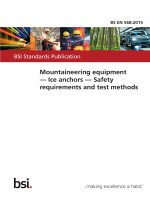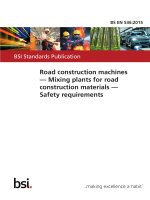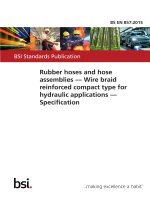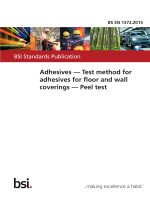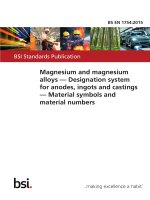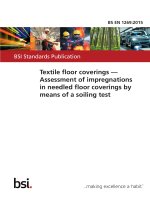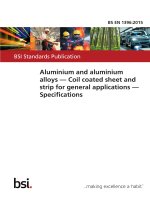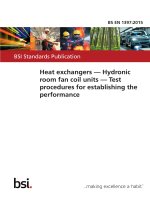Bsi bs en 06032 2015
Bạn đang xem bản rút gọn của tài liệu. Xem và tải ngay bản đầy đủ của tài liệu tại đây (1006.53 KB, 16 trang )
BS EN 6032:2015
BSI Standards Publication
Aerospace series — Fibre
reinforced plastics — Test
method — Determination
of the glass transition
temperatures
BS EN 6032:2015
BRITISH STANDARD
National foreword
This British Standard is the UK implementation of EN 6032:2015.
The UK participation in its preparation was entrusted to Technical
Committee ACE/65, Non-metallic materials for aerospace purposes.
A list of organizations represented on this committee can be
obtained on request to its secretary.
This publication does not purport to include all the necessary
provisions of a contract. Users are responsible for its correct
application.
© The British Standards Institution 2015.
Published by BSI Standards Limited 2015
ISBN 978 0 580 82984 0
ICS 49.025.40
Compliance with a British Standard cannot confer immunity from
legal obligations.
This British Standard was published under the authority of the
Standards Policy and Strategy Committee on 30 November 2015.
Amendments/corrigenda issued since publication
Date
Text affected
BS EN 6032:2015
EN 6032
EUROPEAN STANDARD
NORME EUROPÉENNE
EUROPÄISCHE NORM
November 2015
ICS 49.025.40
English Version
Aerospace series - Fibre reinforced plastics - Test method Determination of the glass transition temperatures
Série aérospatiale - Matières plastiques renforcées de
fibres - Méthode d'essai - Détermination de la
température de transition vitreuse
Luft- und Raumfahrt - Faserverstärkte Kunststoffe Prüfverfahren - Bestimmung der
Glasübergangstemperatur
This European Standard was approved by CEN on 10 August 2013.
CEN members are bound to comply with the CEN/CENELEC Internal Regulations which stipulate the conditions for giving this
European Standard the status of a national standard without any alteration. Up-to-date lists and bibliographical references
concerning such national standards may be obtained on application to the CEN-CENELEC Management Centre or to any CEN
member.
This European Standard exists in three official versions (English, French, German). A version in any other language made by
translation under the responsibility of a CEN member into its own language and notified to the CEN-CENELEC Management
Centre has the same status as the official versions.
CEN members are the national standards bodies of Austria, Belgium, Bulgaria, Croatia, Cyprus, Czech Republic, Denmark, Estonia,
Finland, Former Yugoslav Republic of Macedonia, France, Germany, Greece, Hungary, Iceland, Ireland, Italy, Latvia, Lithuania,
Luxembourg, Malta, Netherlands, Norway, Poland, Portugal, Romania, Slovakia, Slovenia, Spain, Sweden, Switzerland, Turkey and
United Kingdom.
EUROPEAN COMMITTEE FOR STANDARDIZATION
COMITÉ EUROPÉEN DE NORMALISATION
EUROPÄISCHES KOMITEE FÜR NORMUNG
CEN-CENELEC Management Centre: Avenue Marnix 17, B-1000 Brussels
© 2015 CEN
All rights of exploitation in any form and by any means reserved
worldwide for CEN national Members.
Ref. No. EN 6032:2015 E
BS EN 6032:2015
EN 6032:2015 (E)
Contents
Page
European foreword....................................................................................................................................................... 3
1
Scope .................................................................................................................................................................... 4
2
Normative references .................................................................................................................................... 4
3
Terms and definitions ................................................................................................................................... 4
4
Principle of the method ................................................................................................................................ 5
5
Designation of the method ........................................................................................................................... 5
6
Apparatus........................................................................................................................................................... 6
7
Test specimen ................................................................................................................................................... 6
8
Procedure........................................................................................................................................................... 7
9
Presentation of the results .......................................................................................................................... 7
10
Test report ......................................................................................................................................................... 8
Annex A (informative) Equipment ......................................................................................................................... 11
2
BS EN 6032:2015
EN 6032:2015 (E)
European foreword
This document (EN 6032:2015) has been prepared by the Aerospace and Defence Industries
Association of Europe - Standardization (ASD-STAN).
After enquiries and votes carried out in accordance with the rules of this Association, this Standard has
received the approval of the National Associations and the Official Services of the member countries of
ASD, prior to its presentation to CEN.
This European Standard shall be given the status of a national standard, either by publication of an
identical text or by endorsement, at the latest by May 2016, and conflicting national standards shall be
withdrawn at the latest by May 2016.
Attention is drawn to the possibility that some of the elements of this document may be the subject of
patent rights. CEN [and/or CENELEC] shall not be held responsible for identifying any or all such patent
rights.
According to the CEN-CENELEC Internal Regulations, the national standards organizations of the
following countries are bound to implement this European Standard: Austria, Belgium, Bulgaria,
Croatia, Cyprus, Czech Republic, Denmark, Estonia, Finland, Former Yugoslav Republic of Macedonia,
France, Germany, Greece, Hungary, Iceland, Ireland, Italy, Latvia, Lithuania, Luxembourg, Malta,
Netherlands, Norway, Poland, Portugal, Romania, Slovakia, Slovenia, Spain, Sweden, Switzerland,
Turkey and the United Kingdom.
3
BS EN 6032:2015
EN 6032:2015 (E)
1 Scope
This standard specifies a method to determine the apparent glass transition temperatures of nonmetallic materials.
This standard is applicable to unidirectional tape and woven fabric reinforced plastic or plastic
materials like adhesive or neat resin for comparison of the influence on the glass transition temperature
resulting from processing-parameters of non-metallic parts, for compatibility tests for checking cocuring effects of different prepreg types or with adhesive.
This standard does not give any directions necessary to meet health and safety requirements. It is the
responsibility of the user of this standard to consult and establish appropriate health and safety
precautions.
2 Normative references
The following documents, in whole or in part, are normatively referenced in this document and are
indispensable for its application. For dated references, only the edition cited applies. For undated
references, the latest edition of the referenced document (including any amendments) applies..
EN 2374, Aerospace series — Glass fibre reinforced mouldings and sandwich composites — Production of
test panels
EN 2565, Aerospace series — Preparation of carbon fibre reinforced resin panels for test purposes 1)
EN 2743, Aerospace series — Fibre reinforced plastics — Standard procedures for conditioning prior to
testing unaged materials
EN 2823, Aerospace series — Fibre reinforced plastics — Test method for the determination of the effect of
exposure to humid atmosphere on physical and mechanical characteristics 1)
3 Terms and definitions
For the purposes of this document, the following terms and definitions apply.
3.1
glass transition temperature (Tg)
the glass transition temperature is defined for this standard as the temperature where the sample
exhibits a dramatic change in mechanical and damping behaviour with increasing temperature when
subjected to an oscillating displacement
Note 1 to entry: The Tg values are determined by measuring sample stiffness (storage modulus and damping
(loss modulus/tan δ) with increasing temperature using a recommended Dynamic Mechanical Analysis (DMA)
instrument and evaluating the plots against temperature (see Figure 1).
3.1.1
Tg-onset
the Tg-onset is defined as the temperature intersection of extrapolated tangents drawn from points on
the storage modulus curve before and after the onset of the glass transition event
1) Published as ASD-STAN Prestandard at the date of publication of this standard. />
4
BS EN 6032:2015
EN 6032:2015 (E)
3.1.2
Tg-loss
the Tg-Ioss is defined as the temperature where the diagram loss modulus versus temperature has
its maximum
3.1.3
Tg-peak
the Tg-peak is defined as the temperature where the diagram tan δ (damping) versus temperature has
its maximum
3.2
slope angle β
β is the angle of the slope of the storage modulus represented by tangent A (see Figure 1)
4 Principle of the method
Using specially designed equipment of the DMA type the storage modulus, loss modulus and the tan
delta (damping) of a flat plastic sample is automatically measured and plotted while the temperature of
the specimen is raised, at a defined heating rate. Plots of moduli against temperature are evaluated
according to the prescribed procedures to determine Tg-onset, Tg-Ioss and Tg-peak which give an
indication of the maximum service temperature of the material tested.
The slope angle of the storage modulus estimates the drop of mechanical properties due to temperature
effects.
4.1
Method A
The equipment is set to fixed frequency mode at 1 Hz.
4.2
Method B
The equipment is set to resonant frequency mode, initial frequency shall be 20 Hz - 50 Hz.
4.3
Method C
Freely damped torsion pendulum.
5 Designation of the method
The designation of the method used shall be drawn up according to the following example:
Description block
Non-metallic materials
Glass transition temperature (Tg)
Identity block
EN6032 A
Number of this standard
Method (see 4.1 and 4.3)
NOTE
If necessary, the code I9005 may be placed between the description block and the identity block.
5
BS EN 6032:2015
EN 6032:2015 (E)
It should be stated that moduli measured by this method shall not be used for design purposes.
The results obtained by this method vary due to the equipment used. For comparing results the
involved parties shall agree on the equipment used, correlation factors to compare results of different
equipment and the specific material requirements.
A list of recommended equipment is given in Annex A of this standard.
When this method is involved in a material specification, with material requirements the relevant test
equipment according to Annex A shall be stated.
6 Apparatus
6.1 Equipment of the dynamic mechanical analysis type with bending and/or torsional/shear loading
of the specimen, capable of testing and recording frequency, storage modulus, loss modulus, tan delta
and temperature in the ranges used.
Recommended instruments are given in Annex A of this standard.
6.2
6.3
Micrometer with 6 mm fiat faces and accurate to the nearest 0,01 mm.
Vernier caliper accurate to the nearest 0,1 mm.
7 Test specimen
7.1
Test specimen description
The test specimen can consist of either unidirectional tape, woven fabric or adhesive/neat resin. The
fibre orientation is 0° for tape and warp for fabric.
Dimensions : Width and length of the specimen shall be chosen in accordance with the requirements
of the test equipment used.
Thickness
7.2
: (2 ± 0,2) mm (if not otherwise specified) or the nearest ply if fabric material is used.
Test specimen preparation
The specimens are cut out of plates. The coefficient of variation in thickness measurements shall be < 2
% per plate.
Where relevant the reinforced plates shall be manufactured in accordance with EN 2565 (CFRP) or
EN 2374 (GFRP).
The process parameters shall be in accordance with the applicable technical specification.
Precautions shall be taken to avoid notches, undercuts, rough or eneven surfaces after machining.
7.3
Number of test specimens
Three specimens shall be tested per test condition, except when otherwise specified in the applicable
technical specification. If tests are carried out after ageing or at a temperature different from room
temperature, care should be taken to ensure that room temperature/dry reference specimens which
have been machined from the same plate as the specimen under investigation are also tested.
6
BS EN 6032:2015
EN 6032:2015 (E)
7.4
Ageing of specimen
ln case of tests after exposure to humid atmosphere, the conditioning shall be according to EN 2823.
8 Procedure
8.1
Conditioning
Prior to test cured specimens shall be stored at (23 ± 2) °C and (50 ± 5) % relative humidity in
accordance with EN 2743. Aged specimens shall be tested directly after the ageing procedure (a
maximum delay of 8 h at (23 ± 2) °C is allowed).
8.2
Determination of dimensions
Before ageing and mechanical testing measure and record the thickness and width at 3 points in the
non-gripping area of the specimen. Use for the thickness the micrometer (see 6.2) and for the width the
vernier caliper (see 6.3) or the micrometer (see 6.2).
8.3
Calibration
The equipment shall be calibrated according to the manufacturers instructions.
The temperature calibration shall be carried out using Tg-Ioss peaks of agreed grades of:
Polycarbonate
Polyethersulphone
8.4
Testing
:
:
Tg-Ioss, (153 ± 1) °C.
Tg-Ioss, (221 ± 1) °C.
The relevant test parameters shall be used:
Temperature
1.
Heating rate
:
Room temperature to, at least, 20 °C higher than point L or M, see Figure
:
(5 ± 0,2) °C/min (3 °C/min optional).
Specimen dimensions :
Actual.
Clamp the specimen firmly in the sample holder of the equipment used according to the manufacturers
instructions.
Perform the test according to the manufacturers instructions.
9 Presentation of the results
9.1
Diagram
The test results shall be plotted in a diagram according to Figure 1, showing storage modulus, loss
modulus and tan delta (optional) versus temperature.
7
BS EN 6032:2015
EN 6032:2015 (E)
9.2
Determination of Tg-onset
The Tg-onset shall be determined by introducing two tangents into the diagram of the storage modulus
curve, see Figure 1.
The first one (tangent A) representing the linear area of the curve from the start temperature up to
the beginning of the dramatic slope of the curve.
The second one (tangent B) shall be the tangent left of the point of inflection (= tg-Ioss) on the
decreasing part of the curve (see typical diagram Figure 1).
Both tangents shall be extended to intersect in point C.
The temperature related to point C shall be the Tg-onset.
9.3
Determination of Tg-loss
Tg-Ioss is the temperature which corresponds to the maximum of the loss modulus curve (point L in
Figure 1)
9.4
Determination of Tg-peak (optional)
Tg-peak is the temperature which corresponds to the maximum tan-δ (point M in Figure 1).
9.5
Determination of the slope angle β (optional)
Evaluate the slope of the storage modulus curve which is represented by tangent A according to 9.2
(see Figure 1). Determine β by the given formula:
β = arc tan
9.6
∆E'
∆T
Quantitative check
Tg results should be within ± 2,0 °C of their mean. If greater, the results should be scrutinized to see if
they are acceptable.
10 Test report
The test report shall refer to this standard and include the following:
10.1 Complete identification of the material tested, including at least material designation, supplier,
batch number, roll number, fibre areal weight, filament count, processing details, stacking sequence,
test orientation.
10.2 All details regarding specimen preparation including cure parameters.
10.3 The measured specimen dimensions.
10.4 Ageing and/or exposure condition prior to the test.
8
BS EN 6032:2015
EN 6032:2015 (E)
10.5 Date of test, facility and identification of individuals performing the tests.
10.6 Equipment, method and test parameters used including: Displacement amplitude, strain
frequency, strain rate.
10.7 Plot of storage modulus, loss modulus and tan delta (optional) versus temperature, the tangents A
and B and the points C, L and M according to Figure 1.
10.8 Individual test results of Tg-onset, Tg-Ioss, Tg-peak (optional) and β (optional).
10.9 Any incident which may have affected the results and any deviation from this standard.
9
BS EN 6032:2015
EN 6032:2015 (E)
Key
1
2
3
4
5
6
Tg-onset
Tg-loss
Tg-peak
E' (GPa) Storage Modulus
E" (GPa) Storage Modulus
Tan Delta
Figure 1
Typical diagram storage modulus, tan delta and loss modulus versus temperature determination of Tgonset, Tg-peak, Tg-loss and β .
10
BS EN 6032:2015
EN 6032:2015 (E)
Annex A
(informative)
Equipment
The following equipment may be used to determine Glass Transition Temperature.
A.1 PL-DMTA dynamic Mechanical Thermal Analyser
The Technology Centre
Epinal Way
Loughborough
LE 11 OQE
U.K.
A.2 981/982/983 DMA Dynamic Mechanical Analyser
TA Instruments
Silver Side Road
Wilmington,
U.S.A.
A.3 A.T.M. 3 torsion Pendulum,
Myrenne GmbH
5106 Roetgen
Federal Republic of Germany
A.4 Torsiomatic torsion Pendulum,
Zwick GmbH + Co
7900 Ulm
Federal Republic of Germany
A.5 RDS 7700
Rheometrics Inc.
2438 US Hwg 22
Union
NJ 07083
USA
11
This page deliberately left blank
This page deliberately left blank
NO COPYING WITHOUT BSI PERMISSION EXCEPT AS PERMITTED BY COPYRIGHT LAW
British Standards Institution (BSI)
BSI is the national body responsible for preparing British Standards and other
standards-related publications, information and services.
BSI is incorporated by Royal Charter. British Standards and other standardization
products are published by BSI Standards Limited.
About us
Revisions
We bring together business, industry, government, consumers, innovators
and others to shape their combined experience and expertise into standards
-based solutions.
Our British Standards and other publications are updated by amendment or revision.
The knowledge embodied in our standards has been carefully assembled in
a dependable format and refined through our open consultation process.
Organizations of all sizes and across all sectors choose standards to help
them achieve their goals.
Information on standards
We can provide you with the knowledge that your organization needs
to succeed. Find out more about British Standards by visiting our website at
bsigroup.com/standards or contacting our Customer Services team or
Knowledge Centre.
Buying standards
You can buy and download PDF versions of BSI publications, including British
and adopted European and international standards, through our website at
bsigroup.com/shop, where hard copies can also be purchased.
If you need international and foreign standards from other Standards Development
Organizations, hard copies can be ordered from our Customer Services team.
Subscriptions
Our range of subscription services are designed to make using standards
easier for you. For further information on our subscription products go to
bsigroup.com/subscriptions.
With British Standards Online (BSOL) you’ll have instant access to over 55,000
British and adopted European and international standards from your desktop.
It’s available 24/7 and is refreshed daily so you’ll always be up to date.
You can keep in touch with standards developments and receive substantial
discounts on the purchase price of standards, both in single copy and subscription
format, by becoming a BSI Subscribing Member.
PLUS is an updating service exclusive to BSI Subscribing Members. You will
automatically receive the latest hard copy of your standards when they’re
revised or replaced.
To find out more about becoming a BSI Subscribing Member and the benefits
of membership, please visit bsigroup.com/shop.
With a Multi-User Network Licence (MUNL) you are able to host standards
publications on your intranet. Licences can cover as few or as many users as you
wish. With updates supplied as soon as they’re available, you can be sure your
documentation is current. For further information, email
BSI Group Headquarters
389 Chiswick High Road London W4 4AL UK
We continually improve the quality of our products and services to benefit your
business. If you find an inaccuracy or ambiguity within a British Standard or other
BSI publication please inform the Knowledge Centre.
Copyright
All the data, software and documentation set out in all British Standards and
other BSI publications are the property of and copyrighted by BSI, or some person
or entity that owns copyright in the information used (such as the international
standardization bodies) and has formally licensed such information to BSI for
commercial publication and use. Except as permitted under the Copyright, Designs
and Patents Act 1988 no extract may be reproduced, stored in a retrieval system
or transmitted in any form or by any means – electronic, photocopying, recording
or otherwise – without prior written permission from BSI. Details and advice can
be obtained from the Copyright & Licensing Department.
Useful Contacts:
Customer Services
Tel: +44 845 086 9001
Email (orders):
Email (enquiries):
Subscriptions
Tel: +44 845 086 9001
Email:
Knowledge Centre
Tel: +44 20 8996 7004
Email:
Copyright & Licensing
Tel: +44 20 8996 7070
Email:
